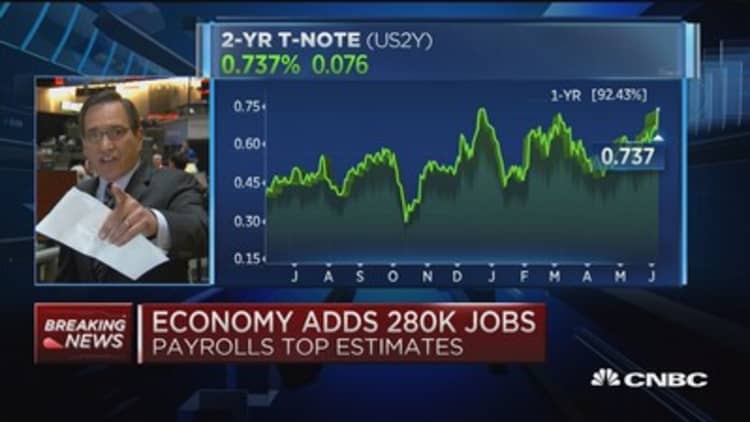
The U.S. economy created 280,000 jobs in May, better than expected and likely confirming hopes that growth is back on track after a slow start to the year.
The headline unemployment rate increased slightly to 5.5 percent as the labor force participation rate ticked higher to 62.9 percent. (Tweet This) A separate measure that counts those working part time for economic reasons and the unemployed who have not looked for work in the past month held steady at 10.8 percent.
Wages also showed growth, rising 8 cents an hour, equating to an annualized increase of 2.3 percent.
Economists had been expecting a gain of 225,000 positions and the unemployment rate holding steady at 5.4 percent.
"Today's report showed the U.S. labor market has tremendous momentum. All those factors that parked a weak jobs number in March were short-term," said Andrew Chamberlain, chief economist at job search site Glassdoor. "All those factors are looking more like a late-winter sniffle than a lingering illness."
The jobs numbers are critical in that they will go a long way toward determining policy from the Federal Reserve. The hot jobs report sent U.S. government bond yields surging as the wage increase indicates inflation is pushing toward the Fed's target. Stock futures also indicated a lower open for Wall Street, though the move in the equity market was far less pronounced than in bonds.
After keeping short-term interest rates near zero for 6½ years, the U.S. central bank is looking for a liftoff point that would be confirmed not only by job creation but also by wage growth, which would indicate inflation is on a positive trajectory.
"I think (the jobs number) puts September more firmly on track" for a rate hike, said Jim Caron, portfolio manager of global fixed income at Morgan Stanley Investment Management. "As of yesterday it was probably closer to a 50-50 bet. Today, I think it's more in lines of a 75 percent probability. It moves the needle in terms of expectations and gives air cover to the Fed."
Trader bets on the date for a rate hike pushed it forward this week, with the latest trends showing a 33 percent chance of a September hike (up from 26 percent earlier in the week), a 52 percent chance in October (from 44 percent) and a 70 percent likelihood for December (from 61 percent).
While many market participants expect a rate increase this year, the Fed got a stunning jolt Thursday from the International Monetary Fund chief Christine Lagarde, who took the unprecedented step of advising the Fed to wait until 2016 until the inflation picture is clearer.
"This number effectively flies in the face of what the IMF recommended yesterday that the Fed take a pause," Caron said.
Service industries led the way for May, adding 63,000 positions, while leisure and hospitality grew by 57,000. Health care increased by 47,000, retail added 31,000 and construction moved higher by 17,000. Mining was a dark spot on the report, contracting by 17,000, bringing the decline to 68,000 in 2015.

The average work week was unchanged at 34.5 hours.
The number of full-time workers grew by 630,000, while the part-time rolls fell by 232,000.
Previous months showed minor changes, with March's disappointing count getting pushed higher to 119,000 from 85,000 and April edging lower from 223,000 to 221,000.
"Overall, at this stage this evident strength in the labor market probably isn't enough to persuade the Fed to hike rates by July, but it definitely makes a rate cut by September probable," said Paul Ashworth, chief U.S. economist at Capital Economics. "Only 24 hours later, the IMF's suggestion that the Fed should wait until 2016 looks very dated."


